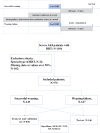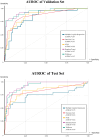Prediction of successful weaning from renal replacement therapy in critically ill patients based on machine learning
- PMID: 38416516
- PMCID: PMC10903749
- DOI: 10.1080/0886022X.2024.2319329
Prediction of successful weaning from renal replacement therapy in critically ill patients based on machine learning
Abstract
Background: Predicting the successful weaning of acute kidney injury (AKI) patients from renal replacement therapy (RRT) has emerged as a research focus, and we successfully built predictive models for RRT withdrawal in patients with severe AKI by machine learning.
Methods: This retrospective single-center study utilized data from our general intensive care unit (ICU) Database, focusing on patients diagnosed with severe AKI who underwent RRT. We evaluated RRT weaning success based on patients being free of RRT in the subsequent week and their overall survival. Multiple logistic regression (MLR) and machine learning algorithms were adopted to construct the prediction models.
Results: A total of 976 patients were included, with 349 patients successfully weaned off RRT. Longer RRT duration (7.0 vs. 9.6 d, p = 0.002, OR = 0.94), higher serum cystatin C levels (1.2 vs. 3.2 mg/L, p < 0.001, OR = 0.46), and the presence of septic shock (28.1% vs. 41.5%, p < 0.001, OR = 0.63) were associated with reduced likelihood of RRT weaning. Conversely, a positive furosemide stress test (FST) (60.2% vs. 40.7%, p < 0.001, OR = 2.75) and higher total urine volume 3 d before RRT withdrawal (755 vs. 125 mL/d, p < 0.001, OR = 2.12) were associated with an increased likelihood of successful weaning from RRT. Next, we demonstrated that machine learning models, especially Random Forest and XGBoost, achieving an AUROC of 0.95. The XGBoost model exhibited superior accuracy, yielding an AUROC of 0.849.
Conclusion: High-risk factors for unsuccessful RRT weaning in severe AKI patients include prolonged RRT duration. Machine learning prediction models, when compared to models based on multivariate logistic regression using these indicators, offer distinct advantages in predictive accuracy.
Keywords: AKI; RRT weaning; machine learning; multivariate logic regression; prediction model.
Conflict of interest statement
None.
Figures
References
MeSH terms
LinkOut - more resources
Full Text Sources
Other Literature Sources
Miscellaneous



